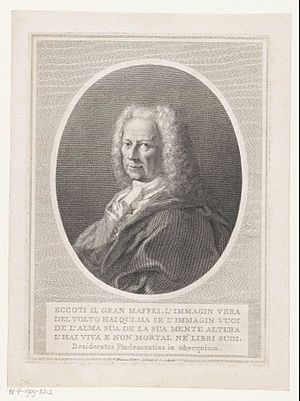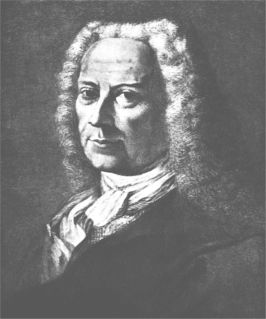Francesco Scipione Maffei facts for kids
Quick facts for kids
Francesco Scipione
|
|
|---|---|

Engraving by Giovanni Marco Pitteri
|
|
| Born | 1 June 1675 |
| Died | 11 February 1755 (aged 79) Verona, Republic of Venice, now Italy
|
| Occupation | Dramatist, Archaeologist, Soldier |
Francesco Scipione Maffei (born June 1, 1675 – died February 11, 1755) was an Italian writer and art critic. He wrote many articles and plays. He was also an antiquarian, which means he studied ancient things. His work on Etruscan history was very important. He often debated with another expert, Antonio Francesco Gori.
Contents
Early Life and Studies
Maffei came from a famous family in Bologna. His brother, Alessandro Maffei, was a general. Francesco studied for five years at a Jesuit college in Parma. Later, in 1698, he went to Rome. There, he joined a group of writers and artists called the Accademia degli Arcadi. When he returned to Verona, he started a similar group there.
In 1703, he joined the army to fight for Bavaria in the War of Spanish Succession. He fought in the Battle of Schellenberg in 1704. His brother, Alessandro, was a high-ranking officer in that battle.
In 1709, Maffei went to Padua. He worked briefly with Apostolo Zeno and Antonio Valisnieri. They edited a literary magazine called the Giornale de' Letterati d'Italia. This magazine did not last very long.
Theatre and Plays
Later, Maffei met an actor named Riccoboni. This meeting made him want to improve Italian theatre. His most famous play was the tragedy Merope, written in 1714. This play became very popular in Europe. People liked it because it moved quickly and did not have a long introduction or a traditional Greek chorus.
He also created Teatro Italiano, a collection of plays, between 1723 and 1725. In 1728, he wrote an original comedy called Le Ceremonie. All of his works were published together in Venice in 1790.
Studying Ancient History
In 1710, Maffei studied old manuscripts in the Royal Library at Turin. He also helped organize a collection of art objects there. From 1718, he became very interested in the ancient history of his hometown, Verona. His studies led to his important book, Verona illustrata, published in 1731–1732.
From 1732 to 1736, Maffei traveled a lot. He visited France, England, the Netherlands, and Germany. In 1732, he went to southern France to study ancient sites. Then he spent four years in Paris. There, he became a member of the Académie des Inscriptions et Belles Lettres, a famous academy for scholars.
In 1736, he visited London. He was chosen as a Fellow of the Royal Society, a group of important scientists. He also received a special degree from Oxford University. He then traveled back to Verona through Holland and Germany. He was good friends with Francesco Algarotti, another famous writer.
When he returned to Verona, Maffei built a museum. He gave this museum, along with his valuable collections of ancient objects and art, to his city. He also gave his collection of old manuscripts to the Verona cathedral. Later in life, he became interested in astronomy and physics. He even built an observatory to study the stars.
- Collection of Francesco Scipione
Ideas on Government and Religion
After his travels in 1736, Maffei wrote a paper called Consiglio politico (Political Advice). He wrote it for the government of Venice. In this paper, Maffei questioned how Venice's government, which was run by a few rich families (an aristocratic government), was set up. He suggested that more people from the Venetian mainland should be able to hold public jobs. He believed in giving people more say in their government, an idea he found in his studies of ancient Roman laws and saw in other countries during his travels.
Maffei never actually gave this paper to the Venetian government. It was only published after his death, just before the fall of the Republic of Venice in 1797. His ideas later influenced other thinkers in Italy, like Carlo Cattaneo.
The Jesuits, a religious order, asked Maffei to write about Christian beliefs. He wrote a book called Istoria teologica, published in 1742. It discussed ideas about God's grace and human free will.
He also wrote a letter and a book arguing against the idea of supernatural magic and witches. He used both scientific thinking and religious arguments from the Bible. This letter was later included in a book by Augustin Calmet about magic and vampires.
Legacy
The 'Liceo Maffei', a high school in Verona, is named after him.
Maffei is also known for describing an invention by Bartolomeo Cristofori. Cristofori created a new hammer mechanism for the harpsichord. This invention is now seen as the creation of the modern piano. Maffei wrote about it in the Giornale de' Letterati d’Italia in 1711. He was one of the editors of this magazine. Maffei later reprinted the article in his own collection of writings, Rime e Prose, in 1719.
The Italian poet Ippolito Pindemonte wrote a poem about Maffei after his death.
Some of His Books
- Per la nascita del principe di Piemonte genteliaco (Rome, 1699)
- Conclusioni di amore (Verona, 1702)
- La prima radunanza della colonia arcadica Veronese (Cervia, 1705)
- La scienza cavalleresca (Rome, 1710), a book against dueling
- De fabula equestris ordinis Constantiniani (Zurich, 1712; Paris, 1714), about the history of knightly orders
- Dell' antica condizione di Verona (Venice, 1719)
- Istoria diplomatica (Mantua, 1727), which published original historical documents
- Teatro del Marchese Maffei (Venice, 1730), his collected plays, including La Merope, La Ceremonie, La Fida Ninfa
- Consiglio politico finora inedito presentato al governo veneto nell'anno 1736 (1736; published in Venice, 1797)
- Graecorum siglae lapidariae collectae atque explicatae (Verona, 1746)
- Della formazione dei fulmini (Verona, 1747), about how lightning forms
- Il Raguet (Verona, 1787), a comedy
- Supplemento al Tesoro delle Inscrizioni di Muratori (Lucca, 1765), a work on ancient inscriptions
Maffei also helped edit the works of important religious figures like St. Hilary (Verona, 1730), St. Jerome (1734), and St. Zeno (1739).
See also
 In Spanish: Scipione Maffei para niños Mérope - a tragedy by Voltaire based on an adaptation of Maffei's drama
In Spanish: Scipione Maffei para niños Mérope - a tragedy by Voltaire based on an adaptation of Maffei's drama




